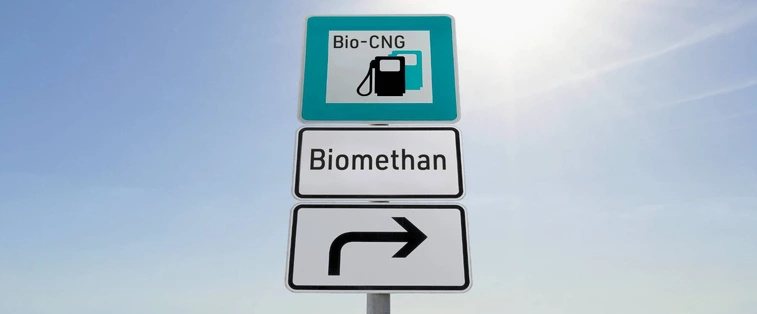

Fueling urban transport with Bio-CNG from sepuran® membranes
Evonik is responding to the challenges of today's security of energy supply: Using the group's innovative SEPURAN® Green membrane technology, pure biomethane can be extracted from biogas released during, for instance, wastewater treatment or organic waste processing, and reused as an alternative fuel for cars, garbage trucks, or city busess.
renewables: contributors to energy security
Renewable power plays a key role in clean energy transitions and it is one of the main enablers of limiting and reusing waste, and achieving energy security. The rise of renewables is steadily growing – according to the International Energy Agency, they accounted for 28.7%, almost two-thirds, of all global electricity generation in 2021. Still, there’s much more development needed in this field to achieve a viable renewable energy mix that includes wind, biogas, solar and hydropower.
Biogas is a byproduct of decaying matter like animal manure, organic waste, specific high-energy crops, sewage and sludge, and even landfills. Consisting primarily of methane, the other main component of biogas is carbon-dioxide. Both are considered greenhouse gases, and as such, would harm the environment if released directly into the atmosphere. Luckily, it is possible to capture and upgrade these gases into usable bio-CNG for powering passenger vehicles like private cars, light trucks, or city buses.
From biogas to BIO-CNG for urban fleet vehicles
Evonik’s SEPURAN® Green membranes are the key elements of processing of biogas. These membranes are housed in canisters and when pressurized biogas is fed through the assembly, a chemical reaction causes the carbon dioxide to separate from the methane. Through a patent protected 3-membrane-stage process, Evonik’s SEPURAN® Green membranes are able to separate methane and carbon dioxide with purity levels of 99% from crude biogas.
The resulting biomethane can then be further processed and compressed to bio-compressed natural gas (bio-CNG), which as a high-density energy source is ideal for use in short-distance vehicles. As bio-CNG burns cleaner than traditional fossil-based fuels, it is highly valued as an alternative fuel for city buses, passenger cars or light trucks that circulate in urban areas.
The renewable aspect of producing bio-CNG with Evonik’s SEPURAN® Green membranes also makes it a great contributor to the circular economy and to achieving the ideal mix of alternative energy sources needed to reach the Net Zero Emissions by 2050 Scenario, set out by the International Energy Agency.
In fact, the benefits that come from using SEPURAN® Green membranes can’t come soon enough. For many policy setters around the world, the increased production of renewable energy is a near-term goal. The European Union, for example, has set a target in its Renewable Energy Directive of having at least 32% of its energy mix from renewable sources by 2030.
Included in this goal are specific targets for a higher use of renewable fuels, like upgraded biomethane, in transport. According to the European Parliament’s “Alternative fuel vehicle infrastructure and fleets: State of play” briefing, as of 2020 there were already more than 26 million CNG and LNG natural-gas vehicles registered in the world, with the world’s growing share of CNG refueling stations are in Asia Pacific, Latin America and the EU. Additionally, it is projected that the currently increasing share of zero- and low-emission cars and vans and buses will rise even more dramatically within the EU between 2030 and 2050.
BIOGAS UPGRADING USING MEMBRANES

Evonik's SEPURAN® Green membrane has been especially developed for the efficient upgrading of biogas into high purity biomethane. In fact, the market entry of Evonik into the biogas upgrading industry in 2011 revolutionized the market and set new technology standards. The introduction of a highly selective SEPURAN® Green membrane in combination with a patent protected 3-membrane-stage process allowed for high methane yields and high product purities with an optimized energy consumption.
Various technologies are available for separating CO2 from raw biogas and upgrading it into biomethane. In addition to well-known technologies such as pressurized water scrubbing, amine scrubbing or pressure swing absorption, membrane technology has become increasingly established in recent years. Thanks to highly efficient and highly selective membranes, it is possible to separate CO2 almost completely from methane in a compact, three-stage process.
Polyimide-based membranes are the most widely used membrane treatment systems. The advantage of membrane upgrading plants over conventional technologies lies, among other things, in the simplicity of the process and the low maintenance requirements. Of course, the spread of biogas upgrading plants is also influenced by local conditions and regulations as well as national incentives.






